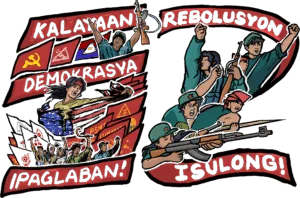Need for Peace Negotiations
The two contending and negotiating parties, the Government of the Republic of the Philippines (GRP) and the National Democratic Front of the Philippines (NDFP) have in their respective ways recognized the need for peace negotiations and have set forth the objectives they wish to achieve.
According to the stalwarts of the national security division of the Arroyo cabinet, the maximum objective of the GRP in pursuing the peace negotiations is to cause the capitulation of the NDFP or facilitate the military victory of GRP and the minimum objective is to conjure false illusions, befuddle the consciousness of the revolutionary forces and people and split the ranks of the revolutionary movement.
The NDFP has been quite open in declaring that the line of struggle for national liberation and democracy is the same line that it pursues in the negotiations for a just and lasting peace. This is the maximum objective of the NDFP in the peace negotiations. The NDFP also has the minimum objective of propagating the national democratic line on issues, arousing the people in their millions to raise the level of revolutionary struggle and seeking allies within the ruling system for the purpose of isolating and defeating the intractable foe.
Since the time of the Marcos fascist dictatorship, I have been privileged to be involved in discreet and public discussions about the question of peace negotiations. I can use the historical method to demonstrate clearly the development of the position and attitude of both the GRP and NDFP about the question of peace negotiations. But such an approach might only ignite a speculative debate about the motivations and calculations of the contending parties. We are on more solid ground if we look at the existing agreements of the two negotiating parties.
Since 1992 the GRP and NDFP have forged twelve agreements. We can use these agreements to determine and measure what the two parties are willing to consider and agree upon as matters in the interest of the Filipino people. The preliminary stage of 1992 to 1995 yielded serious agreements that paved the way for the stage of formal talks from 1995 to the present.
The Hague Joint Declaration was mutually approved by the principals of the GRP and NDFP negotiating panels in 1992. It proclaims the need for peace negotiations in order to address the roots of the armed conflict and arrive at reforms for laying the stable foundation for a just and lasting peace.
It declares the mutually acceptable principles of national sovereignty, democracy and social justice as the guiding principles for the negotiations. It is against any precondition that negates the inherent character and purpose of peace negotiations. It sets the substantive agenda, to include respect for human rights and international humanitarian law, social and economic reforms, political and constitutional reforms.
The Joint Agreement on Safety and Immunity Guarantees (JASIG) was mutually approved in 1995 by the principals of the GRP and NDFP negotiating panels. It protects the panelists, consultants and all other persons duly-authorized in the peace negotiations and provides the mechanism for terminating the peace negotiations by any of the two parties and for allowing persons duly-authorized to participate in the peace negotiation to go to their safe positions within 30 days after the date of the notice of termination.
The Joint Agreement on the Formation, Sequence and Operationalization of the Reciprocal Working Committees was mutually approved in 1995 to guide the drafting of the tentative comprehensive agreements one after the other in accordance with the substantive agenda as set forth by The Hague Joint Declaration. A supplementary agreement was mutually approved in 1997 to require mutual approval by the principals of the comprehensive agreement on social and economic reforms before there can be a negotiation of political and constitutional reforms.
The Comprehensive Agreement of Respect for Human Rights and International Humanitarian Law (CARHRIHL) was approved by the principals of the NDFP and GRP in 1998. This is the first of the four comprehensive agreements in accordance with the substantive agenda. Since 2004, the GRP and NDFP have agreed on the operating guidelines of the Joint Monitoring Committee and has fully constituted it, together with its Joint Secretariat in Manila, to monitor the joint and separate implementation of the CARHRIHL.
At the opening session of the resumption of formal talks in Oslo in April 2001, the NDFP Negotiating Panel and the GRP Negotiating Panel agreed to cooperate in trying to finish the Comprehensive Agreement on Social and Economic Reforms within six months from June 2001. Had the GRP cooperated with NDFP, this comprehensive agreement would have been finished a long time ago. There would have been a chance to finish the comprehensive agreement on political and constitutional reforms in 2002 and that on the end of hostilities and disposition of forces in 2003.
Unfortunately, in June 2001 the GRP suspended indefinitely the formal talks until 2004 avowedly in protest to the killing of Colonel Rodolfo Aguinaldo by the New People’s Army. He was one among the most notorious torturers and murderers of the Marcos fascist dictatorship. Even while in civilian office, he continued to participate in military operations against the NPA and the people in Cagayan province. The NPA therefore had long regarded him as an armed combatant with abundant blood debts.
To further complicate matters, the GRP agreed with the US government in November 2001 to put the CPP/NPA and the NDFP chief political consultant in the “terrorist” list in a bid to pressure the NDFP to capitulate by signing the so-called final peace agreement which the GRP had unilaterally drafted. The US made the “terrorist” listing in August 2002, followed by various other governments (Netherlands, Britain, Australia and Canada) and by the European Council.

